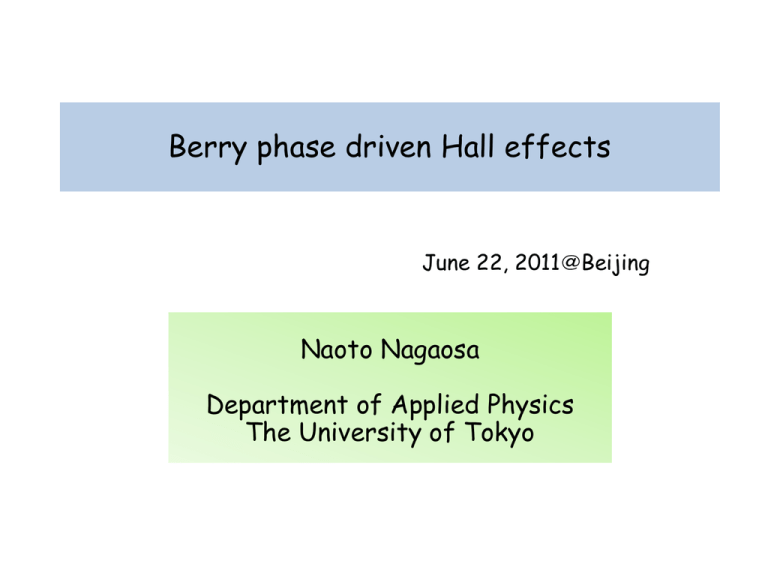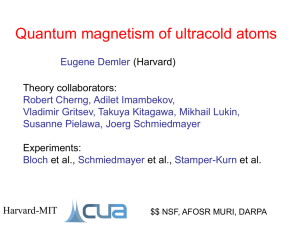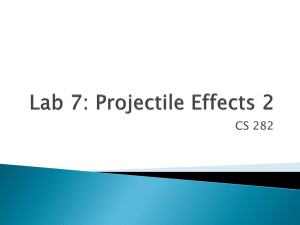Spin chirality induced Hall effects of electrons and
advertisement

Berry phase driven Hall effects June 22, 2011@Beijing Naoto Nagaosa Department of Applied Physics The University of Tokyo Collaborators Theory H. Katsura, J. H. Han, J. Zang, J. H. Park, K. Nomura, M. Mostovoy, B.J.Yang Experiment X. Z. Yu, Y. Onose, N. Kanazawa, Y. Matsui, Y. Shiomi, Y. Tokura Berry phase M.V.Berry, Proc. R.Soc. Lond. A392, 45(1984) En ( X (t )) Transitions between eigen-states are forbidden during the adiabatic change Projection to the sub-space of Hilbert space and constrained quantum system Connection of the wave-function in sub-space of Hilbert space Berry phase, gauge connection t Path integral and Aharonov-Bohm effect x1 aN CN x1 a2 C2 a1 C1 a2 a1 C2 C1 x0 Amplitude from A to B N aj j 1 r r, k , X1 , X 2 , , X n x0 a1a2 | a1a2 |0 eie / c Generalized space Berry Phase Electrons with ”constraint” E E doubly degenerate positive energy states. k k Dirac electrons Projection onto positive energy state Spin-orbit interaction as SU(2) gauge connection Bloch electrons Projection onto each band Berry phase of Bloch wavefunction Solid angle by spins acting as a gauge field |ci> gauge flux Sk Si |cj> conduction electron Sj acquire a phase factor scalar spin chirality Fictitious flux (in a continuum limit) Equation of motion lB l c 1 lB l c 1 dx dk Bk dt k dt k-space Fermi surface Bk e- Luttinger, Blout, Niu dk dr e Br dt r dt r-space Br e- Issues to be discussed 1. Hall effects of uncharged particles -- photons and magnons 2. r-space vs. k-space Berry phase Can neutral particle show Hall effect ? Hall effect of photon M. Onoda et al, Phys. Rev. Lett. 93, 083901 (2004). K.Y. Bliokh and Y.P. Bliokh Phys. Rev. Lett. 96, 073903 (2006). F. D. M. Haldane and S. Raghu, Phys. Rev. Lett. 100, 013904 (2008) O. Hosten, P. Kwiat, Science 319, 787 (2008). Thermal Hall effect by phonon:Tb3Ga5O12 Strohm, Rikken, & Wyder, PRL 95 (‘05). Thermal Hall angle: at 5K. Hall effect of magnons in insulating magnets ? Yes ! [ H.Katsura-N.N.-P.A.Lee (PRL09)] Thermal Hall effect in solids Metals Righi-Leduc effect Wiedemann-Franz law F.D.M. Haldane, PRL 93 (‘04). applicable to AHE also How about Mott insulators ? Spins can carry thermal Hall current ? cf.) Magnon spin Hall effect (S. Fujimoto, arXiv: 0811.2263) Thermal Hall effect by phonon:Tb3Ga5O12 Strohm, Rikken, & Wyder, PRL 95 (‘05). Thermal Hall angle: at 5K. Coupling between spin chirality and magnetic field • Hubbard model with complex hopping ( Second-order: e e ) iij iij Ring-exchange: Scalar spin chirality D. Sen & R. Chitra, PRB (‘95) O.I. Motrunich, PRB (‘06). Spin Chirality due to Spin Wave Scalar chirality: Collinear spin structure: • Geometric Cancellation Ferromagnet: Antiferromagnet 120°structure i i j k i Exact cancellation ∵ j k i 1-magnon term also cancels NO-GO Theorem applicable to many cases ! i) Lattice structure: square(□), triangular (△), kagome, … ii) Magnetic structure: FM ( ), AFM ( ), 120°, spiral, … iii) Anisotropy of hopping → non-uniform • No-go theorem: FM order with an edge-sharing geometry → × Corner sharing geometry, e.g., Kagome !! classical AFM kagome i) ii) Kagome FM Kagome AFM q=0 q=0 g.s. ⇔χ FM g.s. ⇔χ AFM Kubo formula for thermal Hall conductivity Bose distribution function c.f. Matsumoto- Murakami Berry curvature Thermal Hall effect in Kagome ferromagnet Spin Wave Hamiltonian Magnon dispersion Around k=0 TKNN-like formula: T-linear & B-linear! Skew scattering ? Small in the scattering of low energy limit (s-wave). Quantum spin liquid RVB(resonating valence bond)state, P. W. Anderson(‘87) quantum liquid of singlets Mean field theory of RVB state U(1) (internal) gauge-field (constraint: Spinon (charge=0, spin 1/2) ) (S. Frorens & A. Georges, PRB 70 (‘04)) aij : gauge field spin chirality Candidate materials κ-(BEDT-TTF)Cu2(CN)3, ZnCu3(OH)6Cl2, Na4Ir3O8(3d, strong SO), … RVB theory under magnetic field Lee and Lee, O. I. Motrunich • spin model(△): Scalar chirality Slave rotor rep.: Ring exchange term κ-(BEDT-TTF)Cu2(CN)3 Ioffe-Larkin, Nagaosa-Lee Spinon v.s. Magnon Deconfined spinon ( gauge dependent object) coupled to A (via ring exchange term) Lorentz force Magnon (gauge invariant object) coupled to B A intrinsic Hall effect Thermal Hall effect due to spinons spinon metal ・Fermi surface(gapless spinon picture) spinon current conductivity: Wiedemann-Franz law Thermal Hall angle Thermal conductivity in κ-(BEDT-TTF)Cu2(CN)3 M. Yamashita et al., Nature Phys. 5 (‘09) 0.02 W/Km ⇔ @0.3 K T-linear Spinon lifetime Spinon effective mass Thermal Hall angle @ B [T] M. Yamashita et al., Science 328 (‘10) Target material -Lu2V2O7 1 Lu2V2O7 H || [111] H=0.1T M(B/V)) 0.8 0.6 0.4 0.2 Resistivity(cm) 0 insulator xx(W/Km) Collinear ferromagnet 103 102 101 100 Pyrochlore Lattice (111) Plane is Kagome 104 1.5 1 0.5 0 0 50 100 T(K) 150 Thermal Hall conductivity for Lu2V2O7 Lu2V2O7 H||[100] 2 80K 70K (=Tc) 60K 50K 30K 20K 10K 1 xy (10-3 W/Km) 0 -1 -2 2 40K 1 0 -1 -2 -5 0 5 -5 0 5 -5 0 Magnetic Field (T) 5 -5 0 5 Temperature dependence, anisotropy (10-3 W/Km) 2 T=50K 1 0 -1 -10 0 10 0H (T) “spontaneous” component Emergent at Tc Almost isotropic Discussion Origin of thermal Hall conductivity? Possibility of electronic origin can be ruled out by Wiedemann Franz law. xxe<10-5 W/Km below 100K xy decreases with H at low T. Opening of magnon gap xy is observed only below TC. 0 H = 0.1 T 0H=7T 1 1 0.8 0.6 0.4 0.5 M ( B / V4+) xy (10-3 W / Km) 1.5 Coherent magnon transport is crucial for the xy. 0.2 0 50 100 0 T (K) xy is almost proportional to M. irrelevant External H 23 Theory of magnon Hall effect based on DM interaction | i 2 D31 D23 ~ i Je ij J i Dij n Magnons acquire Berry phase owing to DM interaction. 4 3 xy (10-3 W/Km) 1 ( H , T ) C kB2T gB H 2 3 / 2a 2 JS (isotropic) 0 -1 -10 Katsura & Nagaosa ~ i j| JSi S j Dij (Si S j )|i (J / 2 )e ij D12 1 i site xy calc(H) D/J=0.32 H||[100] T=20K 0 Magnetic Field (T) Cf. D/J=0.19 for CdCr2O4 10 c.f. Matsumoto -Murakami 2 g H kBT Li5/2 exp B , 2 JS kBT Gauge field of spin textures in insulating magnets M.Mostovoy, K.Nomura and N.N. PRL2011 Spin dynamics in the intermediate virtual states of the exchange int. Coupling between gauge field e and E Multi-orbital Mott insulator Finite even without inversion asymmetry or spin-orbit interaction Equation of motion dx dk Bk dt k dt k-space Fermi surface Bk dk dr e Br dt r dt one flux quantum/(nm)2~4000T ! r-space e- Bk induced AHE xy 0 , xy 2 “dissipationless” nature Br e- Br induced AHE xy 2 , xy 0 Cf. normal HE xy B / ne, xy xx2 B / ne Pyrochlore Nd2Mo2O7 Mo TC Nd Mo O 2 2 7 30 I(200) I (111) 20 1.5 1 1 0.5 0.5 0 0 T *50 100 Temperature (K) Y. Taguchi, Y. Oohara, H. Yoshizawa, N. Nagoasa, and Y. T., Science 2001 0 150 μ 0 B /Mo) 10 M ( H = 0.5 T) ( R Resistivity (m Ω cm) 2 I ( μ B /2Nd 2 Mo 2 O 7) T* Skyrmion and spin Berry phase in real space Skyrmion configuration From Senthil et al. Solid angle acts as a fictitious magnetic field for carriers S i (S j S k ) a Quantum Phase Transition in MnSi Pfleiderer, Rosch, Lonzarich et al DM magnet Spin fluctuation on a sphere in momentum space Non-Fermi liquid charge transport Small angle neutron scattering for Skyrmion Xtal MnSi S. Mühlbauer et. al., Science 323 915 (2009) c.f. early theoretical prediction by A.N.Bogdanov et al. Skyrmion Crystal Superposition of three Helix without phase shift Q1 Q2 Q3 0 Skyrmion Skyrmion crystal 3-flod-Q S. Muhlbauer et al. Science 323, 915 (2009). Monte Carlo simulation for 2D helimagnet J. H. Park, J. H. Han, S. Onoda and N.N. xy S i (S j S k ) anisotropy Lorentz TEM observation of Skyrmion crystal in (Fe,Co)Si Experiment Theory X. Z. Yu, Y. Onose, N. Kanazawa2, J. H. Park, J. H. Han, Y. Matsui, N. N. Y. Tokura Nature (2010) Coupled dynamics of conduction electrons and SkX J.D.Zang, J.H. Han, M.Mostovoy, and N.N. Effective EMF due to spin texture acting on conduction electrons Coupling term Lorentz force Boltzmann equation LLG equation Skyrmion-induced AHE (MnSi) A. Neubauer et al, PRL 102 186602 (2009) M. Lee, W. Kang, Y. Onose, Y. Tokura, and N. P. Ong, PRL (2009). Finite but quite small Relation to the magnetic structure?? Fictitious magnetic flux ©Y. Tokura one flux quantum/(nm)2~4000T ! (double-excahnge model) l Dyx ∝ (Sk FeGe MnSi MnGe Nd2Mo2O7 (reference) density) l(magnetic) [nm] (cal.) [T] Dyx(topological) [ncm] 70 1 indiscernible 18 28 5 3.0 1100 200 ~0.5 ~40000 6000 “Electromagnetic induction” V Moving magnetic flux produces the transverse electric field j x Conduction electron number per site S Spin quantum number xytop e hz c.f. mc V|| xy Topological Hall effect j j jc j 2S 2S x New dissipative mechanism for spin texture moving flux electric field induced current dissipation (kF l )(a / )2 mean free path l size of Skyrmion ’ does not require spin-orbit int. and can be as large as ~0.1 But is determined by DM interaction. Skyrmion Hall effect V Transverse motion of the Skyrmion as a back-action to the “electromagnetic induction” V Q( ' )(V|| ez ) Q 1 Skyrmion charge determined by the direction of the external magnetic field “Hall angle” tan H ' j Hall Effect of Light Photon also has “spin” Generalized equation of geometrical optics kc velocity: rc v(rc ) kc ( zc | k | zc ) c kc force: kc [v(rc )]kc polarization: | zc ) ikc k | zc ) c M.Onoda, S.Murakami, N.N. (PRL2004) Giant X-ray shift in deformed crystal Sawada-Murakami-Nagaosa PRL06 Berry curvature in r-k space 106 enhancement PRL2010 Berry phase in r-k space D. Xiao et al., PRL (2009) (Real) Space dependent Berry curvature • Semiclassical equation of motion Inhomogeneity-induced polarization D. Xiao et al., PRL (2009) Inhomogeneity-induced topological charge polarization ! (Second Chern form) r P Conclusions 1. Berry phases in r- and k-spaces, and (r,k)-space C 2. Hall effects of uncharged particles photons and magnons 3. Hall effect and charge pumping in spin textures








